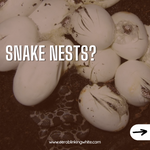Snake nests ?
A common word that I see associated with snake nests. People see a couple of snakes and ask if there is a “nest” nearby. A common myth says that a water skier fell into a “nest” of cotton pastes and died from dozens of bites. When you observe a snake entering or leaving a concrete foundation, a crawl space or a garage, you often think that you have a “nest” of snakes in your territory.
As a wildlife teacher, my problem with the concept of the snake’s nest is that it often evokes unpleasant and inaccurate images in the listener. People imagine an undesirable infestation, like a large number of disease-causing rodents, gathering in a common nesting place and breeding many broods of mice or rats. People who are afraid of snakes often quickly come to the conclusion that the nature of the only snake crossing their yard may indicate a large number of dangerous animals nearby. This is almost never the case.

Do snakes sometimes gather in large numbers?
Of course. Several species of snakes are collected for mating after leaving the brumation (reptile version of hibernation). Often dozens of males are attracted to the female’s pheromones and gather to mate with her. Snakes in the United States that exhibit this behavior include garter snakes (thamnophis) and water snakes (Nerodia). The anaconda (eunectes) from South America is also known for such behavior, which is called “reproductive eggs”.
This behavior is the source of the story about the “nest of gossipers”, which everyone seems to know about. Many people assume that any snake seen in or near water is a cotton mole (also known as a water moccasin). Therefore, when you see a mass of writhing water snakes, a myth is born. However, it is not a “nest”.
Many species of snakes gather in large numbers for wintering in the cave, including several species of rattlesnakes (Crotalus), copperheads (Agkistrodon), rat Snake (Pantherophis), horses (Coluber) and others. They gather in late autumn and diverge in the spring. These caves can be natural, like piles of stones on a mountain slope or the root system of a fallen tree, or the cave can be artificial, like the concrete foundation of a building. However, they are not “nests”.

Sometimes vipers, such as Wald-Klapperschnangen (Crotalus horridus) and the eastern copperheads (Agkistrodon piscivorus), gather in one area to give birth. This is called a deckchair or birthplace. As in the previous examples, the term “nest” is not an exact description here.
Most snakes lay eggs or give live birth to fully experienced young) in appropriate areas without any preparation or modification (nesting). As a rule, these are places such as under or in rotting trunks, in crevices of rocks, dense vegetation, heaps of foliage, animal burrows, loose soil and other natural crevices or holes. Therefore, in the vast majority of cases, the term “nest” would not be applicable even remotely.
Some species of snakes sometimes dig out their own nesting sites, such as pine snakes and ground squirrels (Pituophis) and pig-nosed snakes (heterodon, Leioheterodon). After the masonry, most species of snakes leave the nest and never see their young, which are left to fate. There is some evidence that the female Madagascar giant hognos (Leioheterodon madagascariensis) visits the masonry of its eggs.
Interestingly, there is a kind of snakes that really builds a nest. The female of the royal cobra (Ophiophagus hannah), native to Southeast Asia, collects the leaves into a pile, and then enters this pile to set aside egg-laying. Even more exciting is that the female will actually stay and protect the nest from potential predators, including curious people. After hatching, the female leaves, and the young animals of the cobra remain by themselves. It is a nest, but it is the exception in the snake world, not a rule.
As I have already mentioned, the word “nest” often causes images of dirty rodent masses, walls of houses with ants, termites or cockroaches, a shell-shaped mass of branches made by a bird, or maybe a “tangle” of poisonous snakes just waiting to poison an innocent outsider observer. None of them refers to snakes (with the exception of some of the exceptions described above), but nevertheless, some people like to use the word “nest” in connection with snakes to create fear, spread myths and serve as an excuse for their killing or “extermination”. In fact, “snake’s nest” is a popular expression used by animal export and extermination enterprises.
As with most snake myths, they resolve quickly and easily once we learn the facts.
